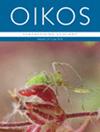Recent increasing homogenisation in Austrian butterfly communities over the past decades
IF 3.1
2区 环境科学与生态学
Q2 ECOLOGY
引用次数: 0
Abstract
In Europe, abundance, biomass and species richness of many insect taxa declined during the last decades. This decline might be accompanied by long-term temporal changes in community composition and dominance orders. Here, we use the data base of the natural history museum of Salzburg based on museum records and field books on Austrian butterflies covering the years 1945–2018 and asked 1) whether and how community composition of important butterfly guilds changed and 2) whether these changes are in accordance with reciprocal shifts in species abundances leading to increased functional stability. In comparisons of annual changes in dominance orders, we found an increasing tendency of compositional stability of dominant species. The trend was most pronounced in generalist and dispersive species, while dominant grassland, xerothermophilic and sedentary species tended to decrease in relative abundance. We also demonstrate a temporal trend towards increasing regional stability in relative abundance rank orders. We did not find compelling evidence for reciprocal shifts in abundances of dominant and subdominant species of the same guild and of asynchronous population fluctuations as required by models that link abundance compensation and functional stability. Our study highlights the ongoing trend towards faunal homogenisation at regional spatial scales in the European Alps.过去几十年来,奥地利蝴蝶群落的同质化现象日益严重
过去几十年间,欧洲许多昆虫类群的丰度、生物量和物种丰富度都有所下降。这种下降可能伴随着群落组成和优势等级的长期时间变化。在此,我们利用萨尔茨堡自然历史博物馆的数据库,以博物馆记录和野外书籍为基础,研究了 1945-2018 年期间奥地利蝴蝶的情况,并提出了以下问题:1)重要蝴蝶行会的群落组成是否以及如何发生变化;2)这些变化是否与物种丰度的相互变化一致,从而导致功能稳定性的提高。通过比较优势阶次的年度变化,我们发现优势物种的组成稳定性呈上升趋势。这种趋势在通性物种和扩散性物种中最为明显,而草地优势物种、嗜热物种和定居物种的相对丰度则呈下降趋势。我们还证明了相对丰度等级排序的区域稳定性增加的时间趋势。我们没有发现令人信服的证据表明同一行业的优势物种和次优势物种的丰度发生了相互变化,也没有发现丰度补偿和功能稳定性相关模型所要求的非同步种群波动。我们的研究强调了欧洲阿尔卑斯山区域空间尺度上动物同质化的持续趋势。
本文章由计算机程序翻译,如有差异,请以英文原文为准。
求助全文
约1分钟内获得全文
求助全文
来源期刊

Oikos
环境科学-生态学
CiteScore
6.20
自引率
5.90%
发文量
152
审稿时长
6-12 weeks
期刊介绍:
Oikos publishes original and innovative research on all aspects of ecology, defined as organism-environment interactions at various spatiotemporal scales, so including macroecology and evolutionary ecology. Emphasis is on theoretical and empirical work aimed at generalization and synthesis across taxa, systems and ecological disciplines. Papers can contribute to new developments in ecology by reporting novel theory or critical empirical results, and "synthesis" can include developing new theory, tests of general hypotheses, or bringing together established or emerging areas of ecology. Confirming or extending the established literature, by for example showing results that are novel for a new taxon, or purely applied research, is given low priority.
 求助内容:
求助内容: 应助结果提醒方式:
应助结果提醒方式:


